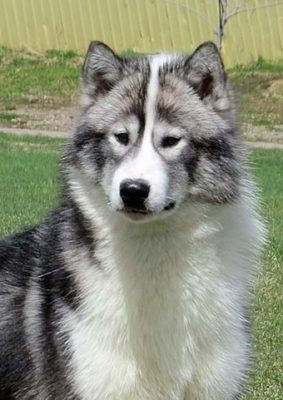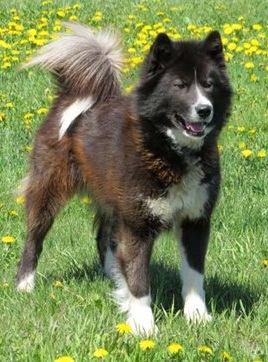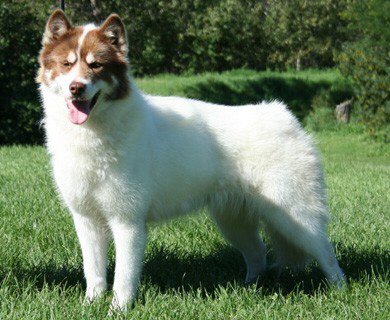Canadian Eskimo Dog
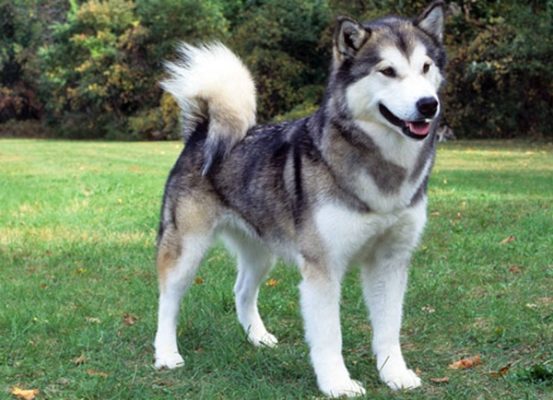
The modern Canadian Eskimo Dog has retained the instincts of a wild animal. Perseverance, endurance, and the spirit of freedom are the working qualities of the husky. In difficult weather conditions, dogs have more than once helped the man. They became “transports” and carried heavy loads. There is no equal to them in terms of riding and endurance.
Table of Contents
Breed Information
| Another Name | Qimmiq, Kingmik, Canadian Husky, Canadian Inuit Dog, C. familiaris borealis, Exquimaux Husky |
| Origin | Canada |
| Height | Males 58-70 cm Females 50-60 cm |
| Weight | Males 30-40 kg Females 18-30 kg |
| Fur | Long |
| Color | White, black, black and white, gray, livery, red |
| Lifespan | 10-15 years |
| FCI Classification | Breeds outside the FCI classification |
| Group | Sled dogs, hunting dogs |
| Price | From $1000 |
Breed Photos
Origin History
There is no consensus on the origin of the Eskimo Husky. The first representatives were seen more than 12,000 years ago. Some scientists consider Alaska to be the homeland; some consider Eastern Siberia, others consider Greenland to be the homeland. One thing is known: Canadian Eskimo Dogs come from the Far North. The homeland left an imprint on the breed representatives: a large reserve of vitality and endurance, which helps them stay active in extreme situations. Throughout history, Canadian Eskimo Dogs have worked hard and endured hardships. This way of life has shaped their appearance: a stern look with a strong-willed character. The breed has been little studied and is currently in danger of extinction.
The naked eye can see the wolf’s habits in the behavior of limits. Although the breed belongs to the Spitz. Representatives hardly bark but emit a long howl, reminiscent of the wolf. In Greenland and Alaska, the animals were used as sled dogs, hunting bears, and other wildlife. Today the Eskimo Husky has no equal in terms of transportation. They can handle all kinds of cargo and long distances.
The modern popularization of the Kimmits occurred in the late 1980s. Breeders were so thoroughly engaged in the restoration of the breed that the Canadian Kennel Club officially recognized Eskimo Huskies. The first representatives were registered in 1986. Ten years later, the Canadian Eskimo Dog was added to the “Northern Breeds” group by the United Kennel Club.
Appearance
The appearance of Canadian Eskimo Dogs corresponds to the Spitz type. At the same time, there is a resemblance to wolves. And not only in appearance but also in character. They are endowed with a compact, large build and developed musculature. The tail of the breed is raised and planted high. The wool is of northern origin, with a long scaly coat and dense undercoat. Its two-layered structure helps the animal easily withstand sub-zero temperatures.
Eskimo Huskies have a large head with a wedge-shaped muzzle. The bite is scissor-shaped. The eyes are brown. Their long legs and muscular body allow the dogs to carry large loads for long distances. Forty kilometers in the cold is just a warm-up for representatives of the breed.
Character
The modern Canadian Eskimo Dog has retained the instincts of a wild animal. Perseverance, endurance, and the spirit of freedom are the working qualities of the husky. In difficult weather conditions, dogs have more than once helped the man. They became “transports” and carried heavy loads. There is no equal to them in terms of riding and endurance.
When an Eskimo Husky comes into the house, it becomes a cozy pet. She gets along well with children and is ready to play all day long. She is devoted to her family. But strangers find it difficult to establish contact with her. The dog is suitable for private and country houses. It gets along better not in the house itself but a spacious enclosure. Animals are not intended for apartments.
Care
The Eskimo Husky does not require any special care. The only thing is that dogs are characterized by heavy shedding. Regularly comb out the hair with a furminator and check the body’s cleanliness, especially during active shedding – once or three times a day in spring and fall. Frequent baths are not necessary. The animal’s coat is impregnated with natural fatty grease. Frequent baths can wash it away.
Training
The sedentary lifestyle is bad for the health of Canadian Eskimo Dogs. They are used to active physical activity. Not only running and harnessing is good, but also skipulling and skijoring. Skimpooling is a winter sport where dogs pull a sled connected to a skier. Skijoring involves a sledding sport where the skier goes the distance with a dog or group of dogs. With proper training, Eskimo Huskies are capable of following any command. All it takes is a couple of training sessions to notice the results.
Common Diseases
Due to the breed’s centuries-old history, representatives are distinguished by strong health and calmly endure the cold. Thanks to their genes, dogs have a strong immune system. With proper care, Eskimo Huskies can live up to 20 years. Diseases include:
- joint dysplasia;
- cataract;
- epilepsy;
- allergies.
Nutrition
Among the natural diet, Canadian Eskimo Dogs love boiled beef and raw boneless saltwater fish. Porridge, cottage cheese, nuts, and dried fruits are also suitable. Vegetables should be given to the pet in shredded pieces and together with other food. Often dogs refuse to eat just vegetables. Do not feed sweet, spicy, or salty foods.
Since dogs are not used to high temperatures, it is worth providing plenty of water during hot periods. Also, limit the consumption of dry food. It is bad for the kidneys and liver. Start small puppies with five meals a day and gradually reduce them to two meals a day as they get older.
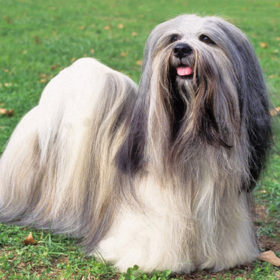 Lhasa Apso
Lhasa Apso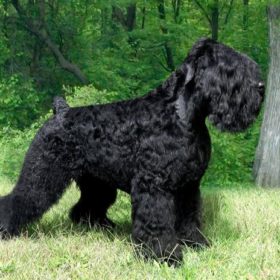 Black Russian Terrier
Black Russian Terrier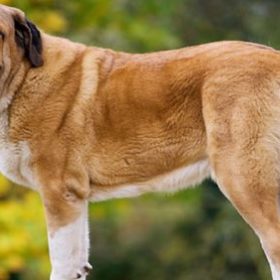 Spanish Mastiff
Spanish Mastiff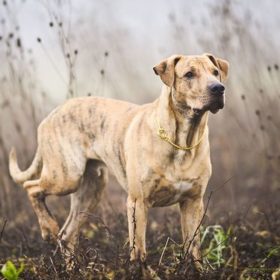 Cimarrón Uruguayo
Cimarrón Uruguayo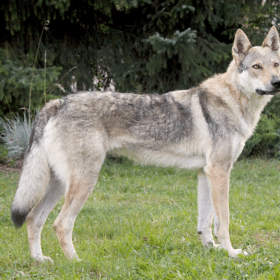 Czechoslovakian Wolfdog
Czechoslovakian Wolfdog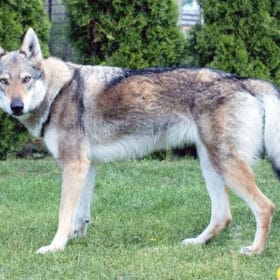 Saarloos Wolfdog
Saarloos Wolfdog